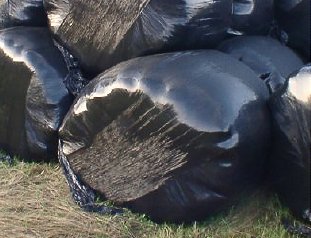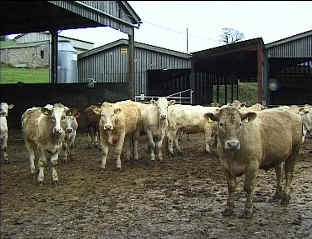|
Before the product is fed in the winter, the farmer will have the silage analysed to find out its feed value. He will then supplement the silage with other more expensive feeds. The profitability of the business largely centres round the feed value of the silage, as well as the quality and quantity of the summer grazing. Efficient grass production and utilisation is the key to success. |
 |
In the winter, one end of the pit will be opened. The method of feeding depends on the livestock numbers and where they are housed in relation to the pit. Cattle often feed directly from the exposed face. The silage can also be removed by machine and put in feeders for livestock to access. |
 |
If the farmer is feeding round bale silage, the outer plastic wrapping (left) is removed. Round bales have an advantage over precision chop silage in that they can be stored outside. They offer the farmer greater flexibility as only one bale needs to be opened at a time. Round bale silage is more easily transported to sheep or beef animals which are out wintering on less productive land. However it is more costly to make. Round bales also require more handling and are therefore less suitable for large herds. |
 |
Housed cattle, whether dairy cows or beef animals, produce dung or slurry which has to be disposed of. The utilisation of this natural fertiliser requires the farmer to make a number of decisions. The cattle are normally housed during the winter when the land is too wet for machinery to travel. For this reason the slurry or dung is stored. The dirty water will often be separated from the solids and pumped over the land through pipes. The solid dung is spread on the grassland when the land is dry enough. However, this waste product takes time to break down and has to be applied well before the grass will be grazed or cut for silage. |
| Continue |
